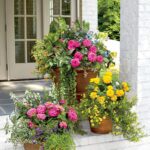Are you looking for vegetable garden design ideas, plan, or layout for your outdoor space? Designing a vegetable garden requires careful planning and consideration to ensure a successful harvest.
The layout of your garden, the types of vegetables you choose to grow, and the overall aesthetic appeal are all important factors to consider. In this article, we will explore the importance of a well-designed vegetable garden and discuss various ideas and tips to help you plan and layout your own garden.
A well-designed vegetable garden is not only aesthetically pleasing but also plays a crucial role in the efficiency and productivity of your gardening efforts. Planning and layout are essential components in creating a successful vegetable garden that yields bountiful harvests throughout the growing season. From choosing the right location for your garden to incorporating sustainable practices, there are numerous aspects to consider when designing an efficient vegetable garden.
When it comes to designing a vegetable garden, one of the first considerations is selecting the right location. Factors such as sunlight exposure, soil quality, and drainage play a significant role in determining the success of your garden. In addition to addressing these practical considerations, incorporating aesthetic elements into your design can elevate the visual appeal of your vegetable garden while maintaining its functionality.
As we delve deeper into this topic, we will explore creative layout ideas for small spaces, tips for planning your vegetable garden’s layout, and suggestions for tailoring your design to specific environmental conditions. Whether you have limited outdoor space or ample room for expansive gardening endeavors, this article will provide valuable insights into creating an aesthetically pleasing and productive vegetable garden.
Choosing the Right Location for Your Vegetable Garden
When it comes to creating a well-designed vegetable garden, one of the most crucial decisions you’ll make is choosing the right location for your garden. The location will ultimately determine the success and productivity of your vegetable plants. There are several factors to consider when selecting the perfect spot for your garden, including sunlight, soil quality, and drainage.
Factors to Consider
Before breaking ground on your vegetable garden, take the time to assess potential locations in your yard or outdoor space. Consider the amount of sunlight that each area receives throughout the day. Most vegetable plants require at least 6-8 hours of direct sunlight, so it’s essential to choose a location that receives adequate sun exposure.
In addition to sunlight, soil quality is another critical factor in determining the success of your vegetable garden. Conduct a soil test to determine the pH level and nutrient content of your soil. Vegetables thrive in well-draining, fertile soil with a pH level between 6.0 and 6.8.
Drainage Considerations
Lastly, consider drainage when choosing the location for your vegetable garden. Avoid areas where water tends to collect or where the soil remains consistently wet after rainfall. Proper drainage is essential for preventing root rot and other issues caused by waterlogged soil.
By carefully considering these factors when choosing the location for your vegetable garden, you can set yourself up for a successful growing season and bountiful harvests of fresh produce.
Vegetable Garden Design Ideas for Small Spaces
When it comes to designing a vegetable garden in small spaces, creativity is key. Urban or limited outdoor areas may not seem conducive to gardening, but with the right layout and design ideas, it’s possible to grow a variety of vegetables even in tight quarters.
Creative Layout and Design Ideas
One of the best ways to maximize space in a small vegetable garden is by utilizing vertical gardening techniques. Vertical gardening involves growing plants upwards rather than outwards, making it ideal for small spaces. Trellises, arbors, and wall-mounted planters can all be used to grow vining vegetables such as tomatoes, cucumbers, and peas.
Additionally, container gardening is another great option for small spaces. Using pots, window boxes, or hanging baskets allows you to grow vegetables on patios, balconies, or even indoors.
Planning for Limited Outdoor Spaces
When planning a vegetable garden for a small outdoor area, it’s essential to carefully consider the available space and sunlight exposure. Opt for compact varieties of vegetables that are well-suited for small spaces and can thrive in containers. Additionally, make use of every inch of available space by incorporating vertical elements like trellises or shelves. By taking advantage of all dimensions of your space – from ground level to eye level – you can optimize your vegetable garden design.
Tips for Successful Small-Space Gardening
In addition to choosing the right location and using creative layout ideas for small spaces, it’s important to regularly maintain your vegetable garden. Proper watering, soil management, and pest control are crucial components of successful small-space gardening. Utilizing environmentally-friendly practices like composting and natural pest control methods will not only benefit your plants but also contribute to a sustainable gardening approach.
Designing a vegetable garden in a small space requires careful planning and thoughtful consideration of layout and design ideas. With the right approach and creative solutions like vertical gardening and container gardening options, even those with limited outdoor areas can enjoy the benefits of growing their own fresh produce. Whether you have a balcony in the city or a cozy backyard patio, there are plenty of opportunities to cultivate an abundance of homegrown vegetables.
Planning Your Vegetable Garden Layout
When planning the layout of your vegetable garden, it’s essential to take into consideration the specific needs of each type of vegetable you want to grow. Here are some tips to help you map out your garden space and determine the best placement for your vegetables:
- Start by sketching a rough outline of your garden space, including any existing structures or features such as fences, trees, or water sources.
- Consider the mature size of each plant when determining how much space to allocate for each type of vegetable. Some plants, like tomatoes and squash, require more room to spread out, while others can be planted closer together.
- Group plants with similar water and sunlight needs together to make watering and care more efficient. For example, place sun-loving plants in one area that receives full sunlight throughout the day, and shade-tolerant plants in another area that gets partial shade.
By carefully planning out the layout of your vegetable garden, you can maximize your growing space and ensure that each plant has the best chance of thriving.
Tips for Determining the Placement of Different Types of Vegetables Include
- Plant tall or trellised crops on the north side of shorter plants to prevent shading.
- Avoid planting heavy feeders like corn next to root crops such as carrots or potatoes, as they will compete for nutrients in the soil.
- Rotate crops from year to year to prevent disease buildup in the soil and maintain fertility levels.
Taking these factors into account when planning your vegetable garden layout can lead to a more productive and visually appealing garden. Remember that flexibility is key – be prepared to make adjustments as needed based on how your plants are actually growing and interacting within their environment.
Incorporating Aesthetic Elements Into Your Vegetable Garden Design
In addition to providing an abundant harvest of fresh produce, a well-designed vegetable garden can also be visually appealing. By incorporating aesthetic elements into your garden design, you can create a beautiful outdoor space that enhances the overall look of your home. When planning your vegetable garden layout, consider adding decorative elements such as trellises, arbors, and raised beds to create visual interest and structure.
One way to incorporate beauty into your vegetable garden is by including flowers and ornamental plants alongside your vegetables. Not only do flowers add color and texture to the garden, but they can also attract pollinators and beneficial insects that contribute to the health of your crops. Consider planting flowering herbs such as lavender or chamomile, or interspersing annual flowers like marigolds or zinnias throughout the garden for a pop of color.
Another aspect of aesthetics in vegetable garden design is creating pathways and borders that define different areas of the garden. Use materials such as gravel, mulch, or stepping stones to delineate paths between planting beds, making it easier to access and maintain your crops. Additionally, consider adding border plants or low hedges to create visual boundaries within the garden while adding structure and order to the space.
When designing your vegetable garden with aesthetics in mind, remember that functionality should not be sacrificed for beauty. Ensure that any decorative elements you incorporate do not hinder access to your crops or impede their growth. By carefully selecting and arranging both practical and attractive features in your vegetable garden design, you can create a harmonious outdoor space that provides both visual enjoyment and a bountiful harvest.
| Vegetable Garden Design Element | Ideas |
|---|---|
| Decorative Elements | Trellises, arbors, raised beds |
| Flowers and Ornamental Plants | Lavender, chamomile, marigolds, zinnias |
| Pathways and Borders | Gravel, mulch, stepping stones; border plants or low hedges |
Sustainable Practices in Vegetable Garden Design
When it comes to designing a vegetable garden, incorporating sustainable practices can not only benefit the environment but also result in a more successful and thriving garden. One of the key aspects of sustainable gardening is minimizing the use of chemical fertilizers and pesticides. Instead, utilizing composting for natural fertilizer, implementing companion planting to deter pests, and practicing crop rotation to prevent soil depletion are all great ways to promote sustainability in vegetable garden design.
Another important aspect of sustainable vegetable garden design is water conservation. This can be achieved through rainwater harvesting, drip irrigation systems, and choosing drought-resistant plant varieties. By reducing water usage and maximizing efficiency, you can create a more environmentally-friendly garden that is better equipped to handle dry spells or periods of water scarcity.
In addition to these practices, it’s also important to select native plant species and varieties well-suited for your specific climate and soil conditions. By doing so, you can reduce the need for excessive watering, fertilization, and maintenance while promoting biodiversity and resilience in your garden. Overall, embracing sustainable practices in vegetable garden design not only benefits the planet but also sets the stage for a beautiful, bountiful harvest year after year.
| Aspect | Description |
|---|---|
| Chemical-free fertilizers | Utilize composting for natural fertilizer |
| Water conservation | Implement rainwater harvesting and drip irrigation systems |
| Plant selection | Select native plant species well-suited for specific climate and soil conditions |
Maintenance and Care for Your Vegetable Garden
Maintaining and caring for your vegetable garden is essential for ensuring a successful harvest. Regular maintenance not only keeps your garden looking its best, but it also helps to promote healthy plant growth and minimize the risk of pest infestations. Here are some important tips to keep in mind when it comes to taking care of your vegetable garden:
- Regular watering: Adequate moisture is crucial for the health of your plants. Be sure to water your garden regularly, especially during dry periods. Consider installing a drip irrigation system to ensure that your plants receive consistent moisture.
- Weeding: Regular weeding is important to prevent unwanted plants from competing with your vegetables for nutrients and sunlight. Spend some time each week removing any weeds from your garden beds.
- Pest management: Keep an eye out for signs of pest infestations and take appropriate measures to control them. This may involve using natural remedies, such as neem oil or introducing beneficial insects, to keep pests at bay.
By staying on top of maintenance tasks like watering, weeding, and pest management, you can help your vegetable garden thrive throughout the growing season.
Lastly, don’t forget about the importance of soil care. Healthy soil is the foundation of a successful vegetable garden. Consider incorporating compost into your soil regularly to improve its structure and fertility. Additionally, rotating your crops each year can help prevent nutrient depletion and reduce the risk of disease buildup in the soil. Taking these steps will help maintain the long-term health and productivity of your vegetable garden.
Vegetable Garden Design Ideas for Different Environments
When it comes to designing a vegetable garden, it’s important to consider the specific environment in which you’ll be growing your plants. Different regions and climates have unique challenges and opportunities for gardening, so tailoring your garden design to these conditions is crucial for success. Whether you live in a hot, dry climate or a cool, wet one, there are plenty of design ideas that can help you make the most of your vegetable garden.
In hot, arid climates, water conservation is key. Consider incorporating drip irrigation systems or using mulch to retain moisture in the soil. Planting heat-tolerant vegetables such as peppers, tomatoes, and okra can also help ensure a successful harvest. Raised beds can be beneficial in these environments as well, as they provide better drainage and allow for better control of soil quality.
On the other hand, in cooler, wetter climates, proper drainage becomes even more important to prevent waterlogging and root rot. Cold-hardy vegetables like kale, broccoli, and carrots are great options for these areas. Additionally, incorporating features such as windbreaks or cold frames can help protect your plants from harsh weather conditions.
No matter where you live, it’s important to choose plant varieties that are well-suited to your specific environment. By doing so and implementing design ideas tailored to your climate and soil conditions, you can create a vegetable garden that thrives and provides a bountiful harvest year after year.
Conclusion
In conclusion, a well-thought-out vegetable garden design is essential for the success of your garden. By carefully planning and laying out your garden, you can optimize the space, ensure proper sunlight, soil quality, and drainage, and create an aesthetically pleasing outdoor space. Whether you have a small urban garden or a larger plot of land, there are plenty of creative ideas to incorporate into your vegetable garden design.
It is important to remember that sustainability should also be a key factor in your vegetable garden design. Utilizing environmentally-friendly practices such as composting, rainwater harvesting, and natural pest control methods not only benefits the environment but also contributes to the overall health of your garden.
As you continue your journey with vegetable gardening, don’t forget the importance of regular maintenance and care. Watering, weeding, and pest management are crucial aspects that should not be overlooked. By implementing the tips and ideas discussed in this article, you can create a successful and thriving vegetable garden that will provide you with an abundant harvest for years to come. Happy gardening.
Frequently Asked Questions
What Is the Best Layout for a Vegetable Garden?
The best layout for a vegetable garden depends on the available space, sun exposure, and the types of vegetables you want to grow. One popular layout is the traditional row garden, with straight rows of plants separated by paths.
Another option is the raised bed garden, which is great for small spaces and offers good drainage. No matter the layout, it’s important to consider companion planting and crop rotation to maximize yield and minimize pest problems.
How Do I Plan My Garden Layout?
Planning your garden layout involves considering factors such as sunlight, water access, soil quality, and potential obstructions like trees or buildings. It’s important to sketch out your ideas on paper first and consider using tools like graph paper or online planning programs.
By determining what vegetables you want to grow and their spacing requirements, you can then plan how to arrange them within your garden space.
What Is the Spacing for Vegetable Garden Layout?
The spacing for vegetable garden layout varies depending on the type of vegetable being grown. For example, larger plants like tomatoes or peppers may need 24-36 inches between each plant, while smaller plants like lettuce or radishes may only need 6-12 inches between each one.
It’s crucial to follow recommended spacing guidelines for each vegetable to ensure they have enough room to grow and receive adequate sunlight and airflow.

Welcome to my gardening blog! I am passionate about plants and enjoy sharing my knowledge and experiences with others. In this blog, I will write about everything related to gardening, from tips on how to get started to updates on my own garden projects.





